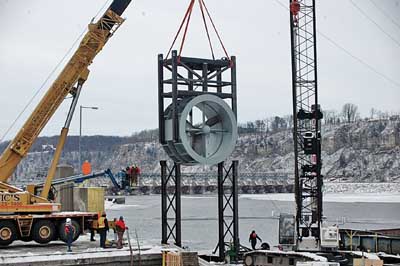What's Damming Hydrokinetic Power in the U.S.?
Barely a month after the U.S. Federal Energy Regulatory Commission (FERC) licensed the nation’s first commercial hydrokinetic power station, Houston-based Hydro Green Energy in January completed installation of the first of two turbines at an existing run-of-river hydropower plant on the Mississippi River for the Minnesota city of Hastings. When the second turbine is installed later this spring, the two hydrokinetic turbines will constitute a floating array that will sit on top of a barge at the Army Corps of Engineers’ Lock & Dam No. 2 (Figure 1).

1. Flotsam and jetsam. Houston-based Hydro Green in January installed the first of two hydrokinetic turbines, each 35 kW, at an existing run-of-river hydropower plant on the Mississippi River for Hastings, Minnesota. When the second turbine is installed later this spring, the grid-connected array will be suspended from a floating barge. Each turbine will drive a generator mounted atop the barge. The array is only the second hydrokinetic project in the U.S. to have garnered federal approval. Courtesy: Hydro Green
Hastings filed its license application for the project with FERC in April and received approval in December last year — a relatively quick turnaround. But, despite increased interest in the emerging sector of marine energy, it is only the second project that the regulatory commission has licensed. The first was awarded in December 2007 to the now-defunct Finerva Renewables’ Makah Bay wave pilot project in Washington State. FERC’s list shows that no other projects are pending licensing.
This isn’t because the U.S. lacks marine energy resources: According to the Electric Power Research Institute (EPRI), the U.S. wave and current energy resource potential that could be credibly harnessed is about 400 TWh per year — or about 10% of national energy demand.
It is true that the U.S. faces the same environmental uncertainties and a long list of technical hurdles, from operation to installation, as the rest of the world. Yet, several nations — with the UK (specifically Scotland) leading the pack — have committed funds and are actively promoting marine energy as a mode of renewable power. And they are reaping results. In January, for example, the Scottish government greenlighted plans for the "world’s largest" wave energy farm, the Siadar Wave Energy Project, which is expected to generate 4 MW when completed by 2011. In September last year, Portugal, another major marine energy player, inaugurated the "world’s first" commercial-scale wave power station 3 miles from the country’s northern coast.
So what is hindering the development of marine energy in the U.S.? According to Roger Bedard, an ocean energy expert at EPRI, the primary barriers are regulatory ones. Today’s regulatory process was designed over a half century ago for conventional hydroelectric plants and is not suited for advanced wave and tidal in-stream energy conversion technologies, he explained. "Because extensive regulation applies to even small pilot projects whose purpose is to investigate the interactions between the energy conversion devices and the environment in which they operate, the regulations are lengthening the time for experimental projects to get off-the-ground and into the water."
Delays are also inevitable for wave energy plants between 3 miles of shore and the edge of the outer Continental Shelf, because both FERC and the Minerals Management Services (MMS) assert jurisdiction in that area, and a developer would have to work with both entities’ regulatory processes. "Just one of the processes is so expensive, a developer cannot afford it unless they are lucky enough to get funding from another government agency to deal with either FERC or MMS," Bedard said. The developer must then "deal with and get approval from a dozen federal agencies and another dozen state and local regulatory agencies." In contrast, permitting processes in countries like Northern Ireland are much simpler. The 1.2-MW Strangford Narrows tidal project — the world’s first commercial-scale tidal energy turbine — which was deployed there last year, for example, had to get approval from only two regulatory agencies.
Bedard noted that FERC has made an effort to streamline its licensing process for pilot projects, shortening it to six months. But he stressed that the cost of regulatory delays to U.S. business is significant and will continue to mount. Without a track record of successful plant operation and of monitored environmental effects, marine energy developers will find it hard to attract capital.